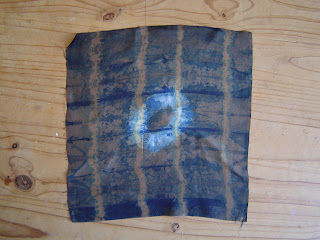Patterned fabrics using Shibori dying:
Below: Fabrics dyed using Shibori technique on cotton lawn and a calico homespun. The dye used was a cold water fibre reactive dye, Drimarene K. Different strengths and fabric produced varying effects illustrated in the photographs below.
The colour used in the following samples was Black 2B which is a green based black dye and the results ranged from a light grey to darker grey approaching black.
Details of resist techniques below from top to bottom are:
1. Homespun with bulldog clips using weaker strength dye (details of recipes on the attached worksheet)
2. Homespun using rubber bands to produce ring effects
3. Cotton lawn using bull dog clips
These patterns can be used as a base for stitchery to produce animal markings similar to turtles, tortoises, lizards or feathers.
Plain dyed fabric below using different strengths of dye mix. The top two samples below were dyed using a weaker strength dye mix on homespun (top) and cotton lawn (middle). It is interesting to see how the dye reacts to the different fabrics, I think the homespun had fabric finish on the surface which resulted in the lighter colour. This is enhanced by the crease marks of the fabric which have taken the dye more than the other areas. This effect was unintentional but has resulted in a natural looking pattern which can be used in stitched work to offset stronger patterned fabrics.
The resultant shade of these samples was a lighter shade than I had envisaged so I mixed second stronger batch of dye mix to try and achieve the darkest shade possible. The bottom sample below shows the cotton lawn fabric dyed with a stronger mix of dye which produced a markedly darker shade.
Shibori techniques using a darker dye recipe. Other techniques were also applied such as painted fabric and application of dye with a rubber stamp providing variety and interest. Different effects were achieved with painting the dye on fabric using a brush or immersing the fabric in a dye bath and allowing to fix for 90 minutes.
 |
| Worksheet showing dye recipes and techniques used |
Arashi Shibori (dye painted on fabric)
 |
| Fabric was twisted as it was pushed together to create crossed lines |
Tie Dye with bulldog clips
 |
| Dye painted on fabric with brush |
 |
Dye immersed in dye bath with fixing time of 90 mins |
 |
| Detail of above sample |
 |
| Tie dye with rubber bands and immersed in dye bath |
 |
| Fabric scrunched into a ball and tied with thread using immersion dye bath |
 |
| Detail of above sample |
 |
| Samples drying in the Summer sun |
Tritik Tibori
 |
| Hand sewn and gathered |
Stamped Fabric
Samples below were dyed using a cold water fibre reactive dye, Drimarene K, in a newly available colour 'Jet Black'. This dyed a darker colour than those above however faded slightly when dried. I also experimented with patterns on previously dyed fabric using discharge past. A purple/brown colour emerged as a result which lends a subtlety to the pattern and tone.
Printing on fabric with inkjet printer:
The samples below show experimentation with printing on cotton lawn inkjet fabric sheets using a copy of paper mono prints and a photograph of owl markings . These printed onto the fabric very successfully and can be used in the sewn samples to add variety and interest as well as a bit of fun.
Below are examples of a previously dyed fabric using Shibori dying techniques and representing patterns found on tortoise shells. The original fabric was saved as a photo file then printed through an inkjet printer to obtain multiple copies on different backgrounds:
1. Printed on organza fabric creating a soft transparent effect that can be used to overlay other fabrics.
1. Printed on organza fabric creating a soft transparent effect that can be used to overlay other fabrics.
2. The paper backing of the organza fabric which creates a byproduct of patterned paper which can be used in paper 'piecing' methods.
3. The same pattern printed on cotton lawn to create a more 'solid' effect and heavier print.
























